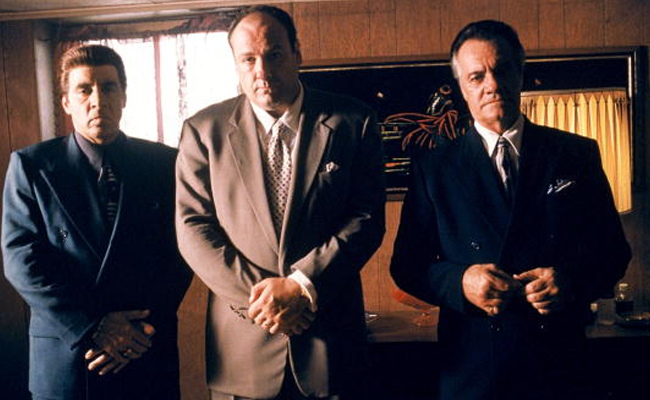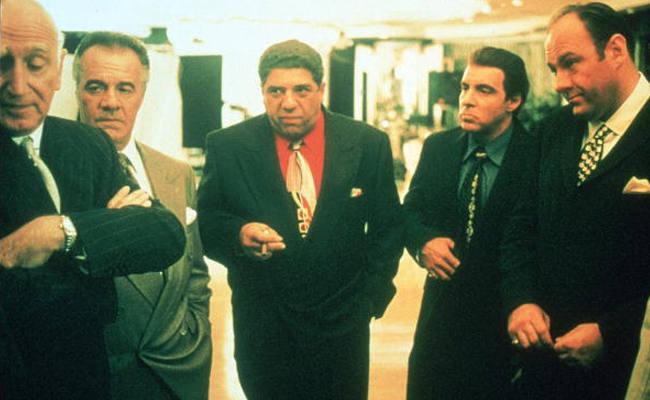
Originally conceiving The Sopranos as a movie, creator/showrunner David Chase had re-written it as a television series, only to have the pilot rejected by all the major networks before being picked up by HBO. While the premium channel already had a long history with original programming, The Sopranos quickly became the reason people would shell out the extra cash to add HBO to their cable package.
Here are some of the more hidden, obscure, or otherwise interesting facts about TV’s game-changing show about everyone’s favorite depressed mobster. Bone up, and then give the show another whirl on HBO Now because it really does hold up.
After the pilot was filmed, a dialect coach was brought in to help create Tony’s voice.
The Sopranos’ pilot was shot in 1997, then shelved for nearly two years, not airing until January 10, 1999. While there are notable differences in the show’s overall tone between the pilot and the second episode, the absence of Tony Soprano’s accent is very conspicuous. Once the series was picked up by HBO, Gandolfini worked with dialect coach Doug Honorof to help create his signature voice.
Most of the cast already knew one another.

The cast of The Sopranos had worked with one another on several projects prior to the series premiere in 1999. Most notably, 27 cast members had roles in Goodfellas back in 1990. They would also appear alongside one-another in Mickey Blue Eyes, Made, Innocent Blood, and Gotti, as well as non-mob movies as diverse as Two Family House, The Basketball Diaries, On the Run, and the Eddie Murphy vehicle The Adventures of Pluto Nash. Alum of The Sopranos still perform in projects together, and HBO even got two iconic characters back together to help promote their new stand-alone streaming service, HBO Now.
Tony’s daughter thought she was auditioning for a musical.
Actress Jamie Lynn-Sigler heard about the role of Meadow Soprano from her manager, who assumed it was for a musical based on the title. When she auditioned for the role, Sigler even brought sheet music with her to the audition, as she is an actual soprano. Even after reading the script, she still thought the show was a musical, “a weird musical, but a musical nonetheless.” To avoid further confusion, which was shared by the network, changes were made to the show’s logo to make it more clear.
There are well-placed nods to The Godfather.
References to The Godfather have been a factor in The Sopranos since the first episode, as the movie is widely regarded as a favorite among Tony and his crew (Silvio’s Michael Corleone impersonation is a particular highlight). So, after a season-long confrontation between Tony and his Uncle Junior comes to a head, an attempt is made on Tony’s life in the episode “Isabella.” In his hands at the time? A racing form and a bottle of orange juice, which was a direct nod to The Godfather‘s well-known symbol for death.
Michael Imperioli’s spec script helped land him a writing job.
Michael Imperioli, who played hothead Christopher Moltisanti, out of pure fandom had written a spec script about his character overdosing on drugs, causing an experience with the afterlife. David Chase gave the script consideration after seeing Spike Lee’s Summer of Sam, which Imperioli had co-written, as well as appeared in. His idea was re-written for Season 2’s “From Where to Eternity,” where Christopher has his experience in the afterlife in the hospital after being shot. Imperioli would go on to write five more episodes for the show during its run.
There was an unintended homage to Fargo.
Probably the show’s most widely discussed episode (outside of the finale), Steve Buscemi directs the almost stand-alone story of Paulie and Christopher, hopelessly lost in the woods of south Jersey after a simple errand goes disastrously wrong. The episodes snow-covered wilderness drew immediate comparisons to the Coen brothers’ Fargo, which Buscemi himself starred in. However, he revealed on the director’s commentary track that while they had chosen that specific location for the episode’s setting, the snow was not planned. They also expected the filming to go easy, when in reality it took 12 days to shoot.
Paulie’s taste in art gives a clue to how the season will end.
In “The Strong, Silent Type,” Paulie recovers a painting that Tony had ordered burned, instead taking it to hang proudly in his own house. After the portrait of Tony makes him uncomfortable, Paulie takes it in for a touch-up, asking the artist to paint over his suit with a uniform “like Napoleon.”
While coming off as one of Paulie’s bizarre quirks, those familiar with Chase’s method of storytelling note the fact that Napoleon’s invasion of Russia is what eventually cost him his empire, and forced him to live in exile. The war drums that played out during the end credits indicated a coming conflict with a once closely allied New York family. However, it was Tony’s brief involvement with a recurring Russian character that would be the catalyst to Season 4’s finale. The moment also played out hilariously the following year.
A series-long extra’s identity is finally revealed.
Throughout the show’s run, the closing credits would regularly list “3 to 5, 7 to 9,” without any real indication of who that was. It wasn’t until the episode “Heidi and Kennedy,” in which two important characters’ funerals take place on the same day, when someone casually observes the character and addresses her by name, which we learn is based on her frequent attendance of wakes and funerals. While an obscure reference, it was a satisfying reward for viewers who’d paid way too much attention over the years.






